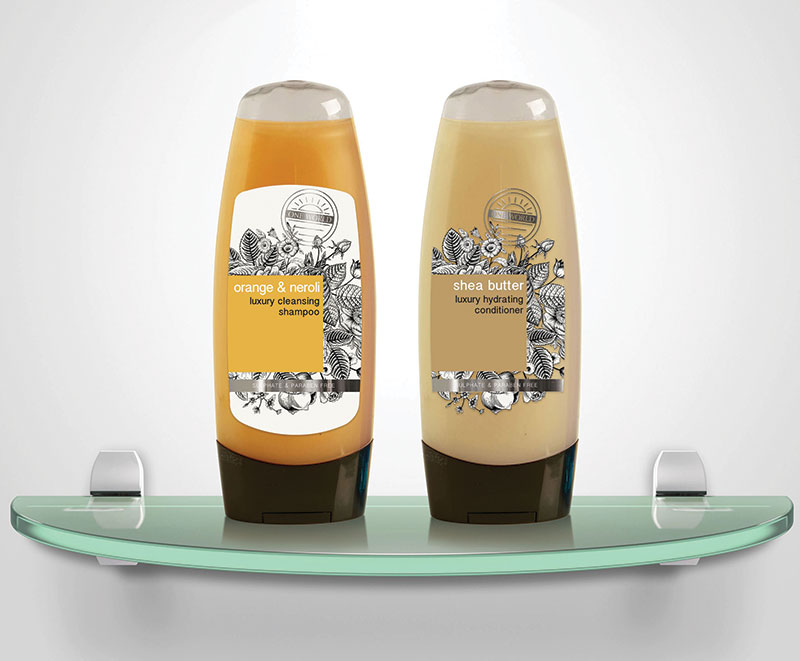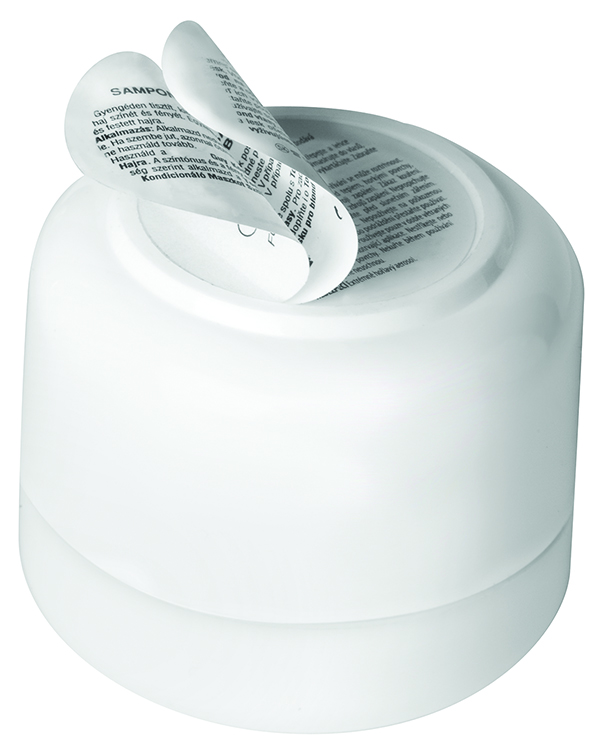Depending on how you define it, the mass sector in beauty has been outperformed by the premium segment for the fourth year running.
That, at least, is the point of departure for RPC’s M&H Division in the UK when discussing labelling, print and other effects. Sales and Marketing Director Simon Chidgey argues that, as a result of this, “decoration remains very much at the forefront”.
Other implications, it could be added, include greater interest in shorter runs, personalised or unique decoration, new effects and the use of contrasting finishes.
Not everything is about dazzling the consumer, though. “Overall, decoration today is looking quite minimalist, with a ‘clean’ aesthetic,” says Julie Vergnion, Category Manager at Quadpack Industries’ Skincare Division.
“At the same time, there are examples of internal coatings being applied to the inside surface of clear plastics bottles to create a frosted effect for a softening of the aesthetics.”
Coated plastics are providing other benefits. “New coating technologies allow the print to minimise the scuffing issues previously a problem, notably in polyethylene terephthalate (PET) bottles,” says Chidgey at RPC M&H.
“Trends in the sector include combination matte and gloss solutions, tactile print and texturing, as well as a vintage look, which is reproducible in print format,” he adds.
Direct print & effects
At Quadpack Impressions, the group’s Spanish decoration business, Engineering Manager David Tanyà outlines three major trends in direct-to-container processes.

“In screen printing, conventional UV inks used to be cured using UV light from mercury vapour lamps,” he explains. Now, lower-temperature UV LED lighting is reducing material distortion and energy consumption, while delivering more durable print.
The plant has installed a new five-colour UV LED press running on materials including plastics and glass.
Secondly, Tanyà confirms the growing popularity of digital print. “It can be a fantastic option for very low or very high runs, or where speed-to-market is important,” he says. “But pricing still works out relatively high for mid-size print runs.” The technology’s strengths include its ability to generate graphics of “photographic quality”, he adds.
Challenges include the fact that digital print heads have, by and large, been designed with flat surfaces in mind, he says, making printing onto curved containers more problematic.
“Finally, the technology behind hot-stamping onto metal and glass has taken huge strides forward,” Tanyà continues.
“Rather than super-heat the foil, the latest techniques lay down a UV primer before the foil is applied.” This allows the company to obtain better adherence, finish and overall quality than ever before, he claims.
Vetroplas Packaging in the UK is supplied by a number of European manufacturing partners, with packs typically decorated at source. Sales Director Simon Dix says: “We’re seeing the use of vignette spraying of colour onto glass frequently requested. We’re now able to offer this not only on one shade but with two colours.”
RPC M&H highlights other possibilities when it comes to closures. “Dip technologies afford exciting options on caps, rendering each one unique,” says Chidgey. The crackle effect is an eye-catching addition for point-of-sale.
Choosing labels over print
At Avery Dennison in Luxembourg, Business Development Manager Monica Gross has expertise in the wines and spirits sector, and offers some insights into the parallels – and differences – between this industry and the beauty segment.
“At the very highest end of the personal care market, it’s all about bottle shape and the materials used for the container,” she says. Direct-to-container print and effects will typically be used to add impact.
Sustainability is an overriding consideration, with an emphasis on the role of adhesives and label facestock in facilitating recycling
“Go to a slightly lower tier of the market, and it’s becoming more of a trend to utilise labels, for example with certain fragrances,” says Gross. “We’re looking at similar trends in super-premium wines and spirits, where paper labels help to create an impression of artisanal, even handmade, authenticity.”
Richly-textured paper labels offer brand owners an additional benefit. “At point of purchase, there’s a need to create tactile effects and activate the consumer’s desire to touch the product,” she says.
Elsewhere, Avery Dennison says that its range of synthetic film substrates, including ultra-clear polypropylene (PP), is still being used selectively to achieve a ‘no-label look’ with the appearance and the appeal of direct print.
At Denny Bros in the UK, Sales and Marketing Director Stephen Jarrold confirms that the ‘no-label look’ still predominates in the sector and that use of multipage labels, such as its own Fix-a-Form format, is fairly limited.
Then again, he says, pressure to communicate with consumers cannot be ignored. “These may well require more than a single-panel label,” he points out.
Of course, sustainability is currently an overriding consideration in many market segments, with an emphasis on the role of adhesives and label facestock in facilitating recycling.
As Avery Dennison’s Gross says: “This isn’t a trend, it’s a reality.”

Monomaterial label-lid-and-container combinations will not always be the easiest or best solution. “We have seen increased interest in the use of bi-oriented polypropylene (BOPP) labels, especially on PET containers, such as personal care products,” says Richard Southward, Global Product Manager for labels at BOPP producer Innovia Films.
The benefit is seen during the recycling process at the plastics flotation stage, when container and label have been shredded. “The higher-density PET sinks to the bottom of the tank, while the lower-density BOPP floats,” he explains.
Sleeve notes
At Sleever International in France, spokeswoman Lucie Ray-Lalanne outlines two trends relating to shrink sleeves and sustainability. “Thinner films are allowing us to reduce the carbon footprint of the package by using less material, but also less energy to produce them and shrink them,” she says.
Secondly, there is a focus on films, which ensure that the bottles they decorate (typically PET) are readily recycled.
When it comes to graphic effects, she says: “We can combine on the same sleeve matte, shiny, texture and tactile effects, transparency, metallic and holographic elements.” Ray-Lalanne argues that sleeves can decorate hard-to-print complex shapes, too.
RPC M&H offers in-house shrink sleeving, but has some reservations about how it should be applied. “Interest in sleeving has grown in recent years, and this affords high digital quality,” says Chidgey.
“But it has issues sometimes in terms of uniformity of shrinking the sleeve onto bottles, and so is most suited to round designs.”
Digital print & in-mould labels
Whether applied direct to containers, pressure-sensitive labels, in-mould labels (IML) or sleeves, digital print continues to offer new options and capabilities.
Jarrold at Denny Bros attaches great importance to the short-run, fast set-up potential of digital. “It may lack some of the more technical embellishments of other techniques, but equally, it may cause manufacturers and brands to reassess what makes product decoration ‘good enough’, while gaining benefits like improved timelines and reduced waste.”
At RPC M&H, Chidgey is cautious about this technology’s impact to date. “While digital print is available, it has not penetrated the sector in direct print to the extent that it has in labels,” he says.

“This is partly due to the challenges on the depth of ink, and also the handling of the substrate.”
For M&H and others, tubes are proving something of a testing ground for digital print. From its plants in France, Spain and the US, CTL-TH Packaging supplies tubes, including its ESTube, to Vetroplas in the UK, among others.
The ESTube uses digital offset IML to create decoration at source, which can be more complex than direct print. At the same time it avoids the challenges of pressure-sensitive labelling.
Dix at Vetroplas has seen the biggest impact of digital print here. “[CTL] achieves a huge range of results, including individually-marked tubes with lower origination costs than traditional methods, such as offset and silk screen printing,” he says.
At the same time, Tanyà at Quadpack is one many emphasising the “photographic quality” achievable with digital.
Invisible intelligence
Intelligent tags may not qualify as ‘decoration’, but whether they are integrated into the container, the closure or – most commonly – into the label, they can add a whole range of benefits for the brand owner and the consumer.
Based in the US, Avery Dennison’s Bob Pernice is Global Director for Market Development in radio frequency identification (RFID) and intelligent labels for the beauty sector.
The company ranks itself as a global leader in ultra-high frequency (UHF) RFID, typically accessed by the supply-chain rather than consumers.
“These systems allow you to identify in parallel a large number of items at once,” he says. “It means retail and e-commerce can make better decisions on how they stock, increasing the availability of each product.”
Intelligent tags, whether integrated into the container, the closure or, most commonly, the label, can add a whole range of benefits
Tags can have an additional security and anti-counterfeit role. “Value [in the beauty sector] is in the strength of the brand, and anything that debases it is a problem,” he says. “So, for example, the diversion of products from the supply chain debases the brand.”
Meanwhile, chip-based technologies such as near-field communication (NFC) are offering new opportunities for consumer interaction. “Brands are really interested in doing anything that will increase brand awareness,” Pernice says.
“Ideally, you want to put [the tag] on the primary pack, so engagement can be continuous and content can change. Above all, the content has to be compelling.”
The perceptions of other packaging producers when it comes to intelligent labels are telling. Chidgey at RPC M&H points out that smart labels and tags “have yet to penetrate the mass sector”.
But Avery Dennison is among those setting great store by (and investing in) the growing range and availability of thinner, flexible, lower-cost integrated circuits for NFC and RFID applications.
Meanwhile, at identification technology specialist Databac, the company’s Managing Director, Charles Balcomb, says: “Connected packaging is on the rise and brand authentication is just one facet of that. That’s why chip manufacturers like NXP are starting to target their products to the beauty sector. We are at the start of a boom in this area and it will be interesting to see how it evolves”.


